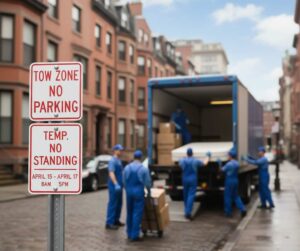Whether you’re planning a local move or a cross-country haul, uhaul trailer rentals offer an affordable and practical alternative to moving trucks. They’re flexible, budget-friendly, and perfect if you already have a tow-capable vehicle. But if you’re new to towing or unsure which trailer fits your needs, this guide walks you through every step, from booking and vehicle requirements to safety tips and return procedures.
Types of UHaul Trailers Available
U-Haul offers multiple trailer types designed for different moving scenarios:
- Enclosed Cargo Trailers: Available in sizes like 4’x8′, 5’x8′, and 6’x12′. These are ideal for protecting items from rain, wind, and theft. Good for boxes, small furniture, and sensitive equipment.
- Utility Trailers: Open trailers with mesh or solid sides. Sizes range from 4’x7′ to 6’x12′. Ideal for landscaping gear, construction material, or bulky items like appliances and furniture that don’t need full coverage.
- Car Trailers: Includes tow dollies (front-wheel towing) and auto transport trailers (four-wheel flatbed). Great for long-distance moves or vehicle deliveries.
- Motorcycle Trailers: Specifically designed with wheel chocks and tie-downs to keep bikes upright and stable in transit.
- Toy Hauler Flatbeds: U-Haul’s newest trailer launched in 2024. It’s 23 feet long and supports up to 6,800 lbs. Built for ATVs, UTVs, or heavy equipment. (Car and Driver)
Booking a Trailer: Step-by-Step
You can book a trailer online through U-Haul’s website or app. After entering your move date and pickup location, you’ll be asked to provide your vehicle’s make, model, and year to ensure compatibility with the selected trailer. U-Haul automatically filters out trailers your vehicle can’t tow based on weight ratings and hitch size.
During checkout, you’ll be offered extras like moving blankets, straps, and insurance coverage. U-Haul often requires a credit or debit card for reservation, although you may pay cash when you pick up the trailer.
Pickup Process & Vehicle Requirements
When you arrive at the U-Haul center, your vehicle will be inspected to confirm it’s suitable for the trailer size you’ve chosen. Requirements generally include:
- A hitch rated for the gross trailer weight (GTW)
- A 1-7/8″ or 2″ hitch ball
- Wiring for trailer lights (4-way flat connector minimum)
- Safe tire tread and functional tail lights
If you’re missing any of these, many locations offer same-day hitch installations or wiring kits on-site.
Safety Before You Hit the Road
Here’s what U-Haul recommends every renter do before towing:
- Double-check the hitch connection and locking pin
- Ensure safety chains are crossed under the tongue and securely attached
- Test brake lights and turn signals
- Distribute weight with 60% forward of the axle and 40% behind
- Keep maximum speed at or below 55 mph
Larger enclosed trailers like the 6’x12’ model include surge brakes that automatically activate when your vehicle slows down. Be aware of stopping distance, avoid sudden maneuvers, and take turns wider than usual.
Loading the Trailer Correctly
Proper loading is key to safe towing. Place the heaviest items at the front of the trailer, centered over the axle. Balance the rest of the items evenly and secure everything tightly with tie-down straps or bungee cords. U-Haul recommends that cargo doesn’t shift more than an inch in any direction once secured.
Using moving blankets, furniture pads, or stretch wrap can reduce damage to delicate furniture. If you’re transporting a mattress, wrap it in a waterproof bag to protect it from road debris or weather.
Real Example: One-Way Trailer Rental
Say you’re moving from Nashville, TN to Pittsburgh, PA. A one-way 5’x8’ enclosed trailer may cost around $175–$200 for a 3–4 day rental period. That includes unlimited mileage. Add $5–$11/day for Safetow insurance and around $15–$25 for supplies like straps and blankets.
Compare that to a moving truck ($400+), and you can see why trailers are popular with DIY movers or students who already have a capable SUV or pickup.
Returning the Trailer
When your move is complete, return the trailer to the U-Haul location listed in your reservation. You can also use the 24/7 return option with the mobile app, just take a few photos to document the trailer’s condition and follow the steps to complete the drop-off digitally.
Returning the trailer clean and free of damage ensures you won’t face additional fees. If you’re late, U-Haul charges a per-day overage based on the original quote.
Cost Breakdown Table
| Trailer Type | Typical Size | Price Range (One-Way) | Best For |
|---|---|---|---|
| 4’x8′ Cargo | Small, enclosed | $100–$150 | Boxes, small furniture |
| 6’x12′ Utility | Open bed | $120–$190 | Furniture, appliances |
| Auto Transport | 14′ long | $180–$250 | Moving a vehicle |
When to Choose a U Haul Trailer Over a Truck
Choose a trailer when:
- You already own a towing vehicle
- You’re moving a small apartment or just furniture
- You’re hauling items locally or for a short distance
- You want to avoid high gas costs or rental insurance premiums
On the other hand, a truck may be better if you’re moving a large household or don’t have a proper tow vehicle.
Final Thoughts
Uhaul trailers are an affordable, flexible way to move items of all sizes, especially if you have a compatible vehicle and want to avoid the expense of a full truck. With easy booking, wide availability, and multiple trailer types, it’s a go-to solution for everyone from college movers to contractors hauling gear.
Need help planning your trailer move? Coastal Moving Services can assist with hitch setup, loading strategy, and packing support. Call +1‑334‑659‑1878 to get started today.








